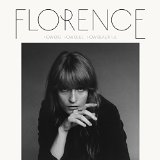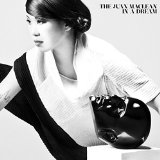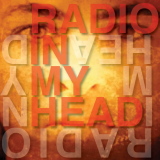 Florence + The Machine is a relatively rare and interesting type of multi-million selling global superstar to be found in this or even the past decade. She is more suited to the mid-eighties/nineties stretch of pop stars that included Kate Bush, Prince and Bjork – artists that used idiosyncratic and sometimes iconoclastic imagery that was key to their success but didn’t define it and whose music was frequently strange and brilliant but sold by the shed load. Where Florence Welch differs from her idols though is that her musical choices so far have found the singer already approaching what could be regarded as caricature of herself. Her debut album “Lungs” was a rag-tag but solid collection of goth-pop which established her eclectic eccentricity and 2011’s highly polished “Ceremonials” had some fantastic songs which were often marooned in a samey, shouty and exhaustingly one-note soundscape. “How Big, How Blue, How Beautiful” sees Florence set out to actively change this, to breath nuance and restraint and personal experiences into an album’s worth of songs.
Florence + The Machine is a relatively rare and interesting type of multi-million selling global superstar to be found in this or even the past decade. She is more suited to the mid-eighties/nineties stretch of pop stars that included Kate Bush, Prince and Bjork – artists that used idiosyncratic and sometimes iconoclastic imagery that was key to their success but didn’t define it and whose music was frequently strange and brilliant but sold by the shed load. Where Florence Welch differs from her idols though is that her musical choices so far have found the singer already approaching what could be regarded as caricature of herself. Her debut album “Lungs” was a rag-tag but solid collection of goth-pop which established her eclectic eccentricity and 2011’s highly polished “Ceremonials” had some fantastic songs which were often marooned in a samey, shouty and exhaustingly one-note soundscape. “How Big, How Blue, How Beautiful” sees Florence set out to actively change this, to breath nuance and restraint and personal experiences into an album’s worth of songs.
Markus Dravs has taken over almost all production duties from Paul Epworth (who still co-produces one track here) and has laid down the law, it seems, telling Welsh that certain well-worn subjects are off-limits, such as water metaphors (a few still slip through the net, excuse the pun) and an early song called “Which Witch” bought to him by Welch was rejected because of song title only (and that too still appears, but as a bonus track only). He wanted to put her voice up front and to be more exposed and vulnerable, less multi-tracked, and for the music to also have space to breathe. Will Gregory, the introvert half of Goldfrapp, was bought on board as Welch wanted lots of brass and she’s certainly got her wish. It seems that there was some compromise on both sides, as this is a different Florence album in part, but it is not to be considered as any real, radical departure in sound. With the strength of songwriting on display here and a successful transition to more interesting and diverse soundscapes this is not important, it’s the most balanced and cohesive album that Welch has made thus far.
The first song to be heard from “How Big, How Blue, How Beautiful” was the striking “What Kind of Man”. With Welch’s voice manipulated to echo that of Karin Andersson from The Knife, she sounds genderless and possessed and it’s something of a shame that guitars and drums crash in all too soon. The mania and panic associated with Welch and evidenced here again is offset beautifully by a return to the coolness of this initial refrain though and “Ship to Wreck”, with its soaring near gospel middle-eight, continues with the indie rock motifs . The title track’s opening line ‘between a crucifix and the Hollywood sign’ is not the only thing that sounds like you might hope a Madonna track would in 2015; it has a spaciness and warmth that is designed to be heart- swelling and it is. The long instrumental play-out is the most optimistic that a Florence track has ever sounded, assertive trumpets and forthright strings herald a new dawn with all of its possibilities. Sounds cheesy perhaps but it’s sincere and as gorgeous as hell.
“Various Storms & Saints” and “Long & Lost” continue with an acoustic, bare bones but lush instrumentation and “Caught” is a mid-tempo r’n’b song with an unexpected country sway and is swoonsomely heartbroken. Over a plaintive organ and understated orchestration it is “St Jude” which cements absolute melodic perfection with Welch’s forever fallen angel, compulsively drawn to chaos. “Delilah” and “Third Eye” will delight the Florence diehards with both tracks pulling across the established, bombastic and commercial sound from her previous two albums and turning the dial up even further to not-quite ludicrous settings. Album closer “Mother” incorporates all of these ingredients but stirs them about with a 1970’s blues-rocker shtick that creates something altogether more strange and the final, thrashing fifty seconds genuinely excite. Florence + The Machine may never be able to do subtle but with “How Big, How Blue, How Beautiful”, Welch has made considerable progress with making music that is more complex, satisfying and timeless sounding than before, never alienating her current fan base and undoubtedly attracting many more new ones in the process.
 ‘Flights, in the night’ sings Nancy Whang conspiratorially during a quiet portal in the impressively detailed “A Place Called Space” that opens The Juan Maclean’s third album proper. Nothing sums up Whang and Maclean’s manifesto quite as perfectly as that line. Alluding to a retro glamour which no longer exists and a promise of a decadent and clandestine other world where the only light is artificial and strobing. This line, better still if it were morphed into a song title, could have been uttered on any number of Donna Summer’s tracks which featured on her most essential, electronic and nocturnal albums made between 1977- 1979 and produced by Giorgio Moroder. As if to hammer this point home Whang has simultaneously released an EP under her own name which is a collection of Casablanca records cover versions, it includes a faithful interpretation of Summer’s slippery and melancholic “Working the Midnight Shift”. “In A Dream” is a record that may wear its influences heavily on its sleeve but the cluster of magnificent songs and the vocal dynamics honed between the two prevents it from falling into a potentially deep hole of nostalgia and tribute.
‘Flights, in the night’ sings Nancy Whang conspiratorially during a quiet portal in the impressively detailed “A Place Called Space” that opens The Juan Maclean’s third album proper. Nothing sums up Whang and Maclean’s manifesto quite as perfectly as that line. Alluding to a retro glamour which no longer exists and a promise of a decadent and clandestine other world where the only light is artificial and strobing. This line, better still if it were morphed into a song title, could have been uttered on any number of Donna Summer’s tracks which featured on her most essential, electronic and nocturnal albums made between 1977- 1979 and produced by Giorgio Moroder. As if to hammer this point home Whang has simultaneously released an EP under her own name which is a collection of Casablanca records cover versions, it includes a faithful interpretation of Summer’s slippery and melancholic “Working the Midnight Shift”. “In A Dream” is a record that may wear its influences heavily on its sleeve but the cluster of magnificent songs and the vocal dynamics honed between the two prevents it from falling into a potentially deep hole of nostalgia and tribute.
If their 2005 debut album was an accurate record of the post-electro clash, nihilistic and disco-damaged DFA early days and the follow up and homage of sorts to British synth pop and handbag house then this record is where the pair decide to reach back even further. There has always been a vivid and brattish clutch of songs that have been hard to ignore in The Juan Maclean’s back catalogue, screaming and shouting for attention and not fully formed. “In A Dream” has eliminated these kinds of distractions and is all the better for it; Nancy Whang is afforded full vocals on six of the nine tracks here and is having a ball in the process. Her voice is not that of a disco diva although frequently this is precisely what the sonics would appear to dictate. It has a flat and disinterested quality and still, somehow, considerable charisma, and Whang can interchange between dismal, withering betrayal and a warm optimism that dominates for example the gradually unfurling and uplifting ten minute closing track “The Sun Will Never Set on Our Love”. Tellingly this is their first album to feature just Nancy Whang as the cover artist, overshadowing a metallic bust of a physically absent Maclean.
“You Were a Runaway” has a choppy and to-the-point Grace Jones type pop structure. “Running Back To You” with its gorgeously padding synth swirls and reference to Imagination’s slinking 1980 hit “Body Talk” is the album’s only mid-tempo song and sees Whang softened but not entirely submissive. “Love Stops Here”, which may have the album’s strongest melody, puts Maclean upfront and sounds like a very good LCD Soundsystem song with washes of New Order guitar along with Whang’s glorious ‘do do do’ refrain popping up for the very last moments. “I’ve Waited for so Long” is a tight and confrontational “Don’t You Want Me”- styled trade-off between the two vocalists. It borrows the bassline from Cerrone’s “Supernature” but like so much of the material here the duo detail and layer the soundscape to the point where it isn’t pilfering but perfecting a sound that is, within the confines of this album, completely theirs.
Two of the most complete and satisfying songs, the aforementioned Moroder-indebted “A Place Called Space” and the penultimate track “A Simple Design”, both featuring a dominant Whang vocal, see The Juan Maclean finally solidify an effortless and endearing personality. Since “Less Than Human” the couple have spent a decade attempting to gel in a way that allows them both to share the lead, a hard feat indeed as Whang is not just a ‘front woman’ and neither is Maclean an invisible producer in the mould of, say, Goldfrapp. With Maclean cast in the role of an outsider and a muted and occasional vocalist to boot, you feel that he is now happier to concentrate on perfecting the world that surrounds the two and less inclined to push his voice to the front in a way that has read as self-conscious before. It is impossible to imagine him for example delivering the stand-off line ‘time after time, when what you’re hoping to find is not a simple design but a headache!’ from “A Simple Design” with the same brutish gusto as Whang does. Both roles are of equal importance and “A Place Called Space” sees The Juan Maclean arrive at their ultimate destination; confident, possessed and prepared to share it with us. We should think ourselves lucky.
 The phrase ‘an acquired taste’ could have been made for Polly Scattergood. She has a little girl lost voice and a tendency to cast herself as a needy victim to such an extent that the preference may be to send her to a good psychoanalyst than indulge in her recorded confessions. Her self-titled debut included a song called “I Hate The Way” in which Scattergood listed all of the things wrong with her and included the line ‘not all men are bad and I’m not like your dad and I’ll hold you even though you’re slightly mad’ sung from the perspective of her boyfriend. But she can have a way with a tune and her best tracks were perverse and genuinely dark, atmospheric electro pop songs. “Arrows” picks on up the synth-pop element of her first collection and broadens it with ballads as contrast; this is an album that is more slow than fast, are just as black-hearted and desperate.
The phrase ‘an acquired taste’ could have been made for Polly Scattergood. She has a little girl lost voice and a tendency to cast herself as a needy victim to such an extent that the preference may be to send her to a good psychoanalyst than indulge in her recorded confessions. Her self-titled debut included a song called “I Hate The Way” in which Scattergood listed all of the things wrong with her and included the line ‘not all men are bad and I’m not like your dad and I’ll hold you even though you’re slightly mad’ sung from the perspective of her boyfriend. But she can have a way with a tune and her best tracks were perverse and genuinely dark, atmospheric electro pop songs. “Arrows” picks on up the synth-pop element of her first collection and broadens it with ballads as contrast; this is an album that is more slow than fast, are just as black-hearted and desperate.
“Wanderlust” has a Numanesque overarching synth and sounds like Goldfrapp at their squelchiest. It’s nice but derivative and the silky “Disco Damaged Kid” is one of the many songs here that builds into something very different from its first couple of minutes but fails to live up to the vivid imagery suggested in its title. “Falling” has a rougher New Order indie pop sound and “Machines” is a standout, a tender electronic ballad which builds to a convincing enough passionate climax. “Subsequently Lost” is probably the pop standout, a PSB type production, tight with an ‘I’ve subsequently lost my mind luv, apparently I’m going nowhere’ chorus which very much sums up Scattergood’s opinion of herself.
The album’s final track “I’ve Got A Heart” is appropriately heart-breaking; piano and synth chords, beautifully spaced out moments and also the confessional ‘the doctor gave me pills to take, to stop me feeling quite so awake’ line accompanied by strings which help play out the tracks final two minutes. If you don’t like this track then it’s unlikely that Polly Scattergood will be for you. Alternatively the piano led ballad “Miss You” crams in all of her less sympathetic aspects, lyrically and also in respect to performance. It’s whimsical and self-pitying with juvenile lyrics referring to bedroom floors and chimneypot-lined skies.
“Arrows” is an album that sees Polly Scattergood lose some of the things that made her debut oddly compelling. She is clearly attracted to melancholy and that dark disco aesthetic that’s loved by many similar artists but here she is both more diluted and obvious than before. The thing that marked her out as being different, her own relentless self-involvement and a singing style which manages to be downtrodden and girly, are still here but the songs let her down more often than not. The surreal flourishes of songs like “Nitrogen Pink” and “The Bunny Club” from her debut have been replaced by more straightforward song writing and themes and where Scattergood was very good at narrating these kinds of escapist fantasies she is less effective with these kitchen sink type scenarios. There is a place in the electro pop world for Polly Scattergood I’m sure but she many have to go back to her initial influences and eccentricities to push her way back through the very crowded door.
 Well that’s just about got the British summer out of the way and we’ve got a few months of good music before the silly season of compilations and box sets starts all over again. After a surprisingly good August, we’ve got a very busy September lined up for you.
Well that’s just about got the British summer out of the way and we’ve got a few months of good music before the silly season of compilations and box sets starts all over again. After a surprisingly good August, we’ve got a very busy September lined up for you.
We’ll be reviewing Texan fiddle player/singer/songwriter Carrie Rodriguez live in London and we should finally get to see the Anna-Christina solo show, “Pretty Little Lady?” towards the end of the month. We’ve also got our only festival review of the summer from Lou; live at Leeds. I’m sure we’ll find a few other gigs to tell you about as well.
John’s going to be reviewing the new material from Ultraista, Dawn Richard, Icona Pop, Natalia Kills and Goldfrapp while I’ve got the debut Dirt Tracks album for you and whatever else the postman or the internet send my way in the next few weeks. The long-awaited Radio (in my) Head project is about to launch and we’ll have some news about that for you next week. We’re also starting a new regular piece featuring links to new music we think you might like to hear. More in a few weeks.


